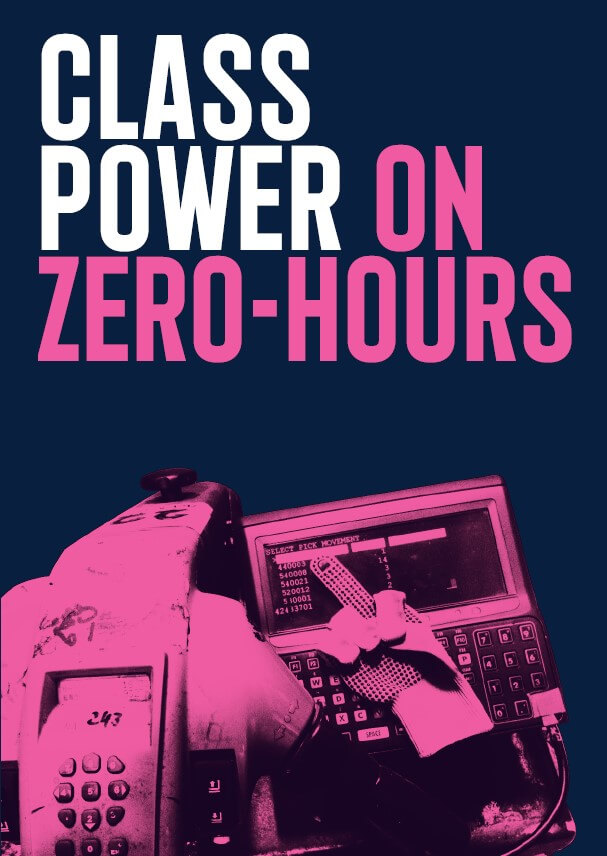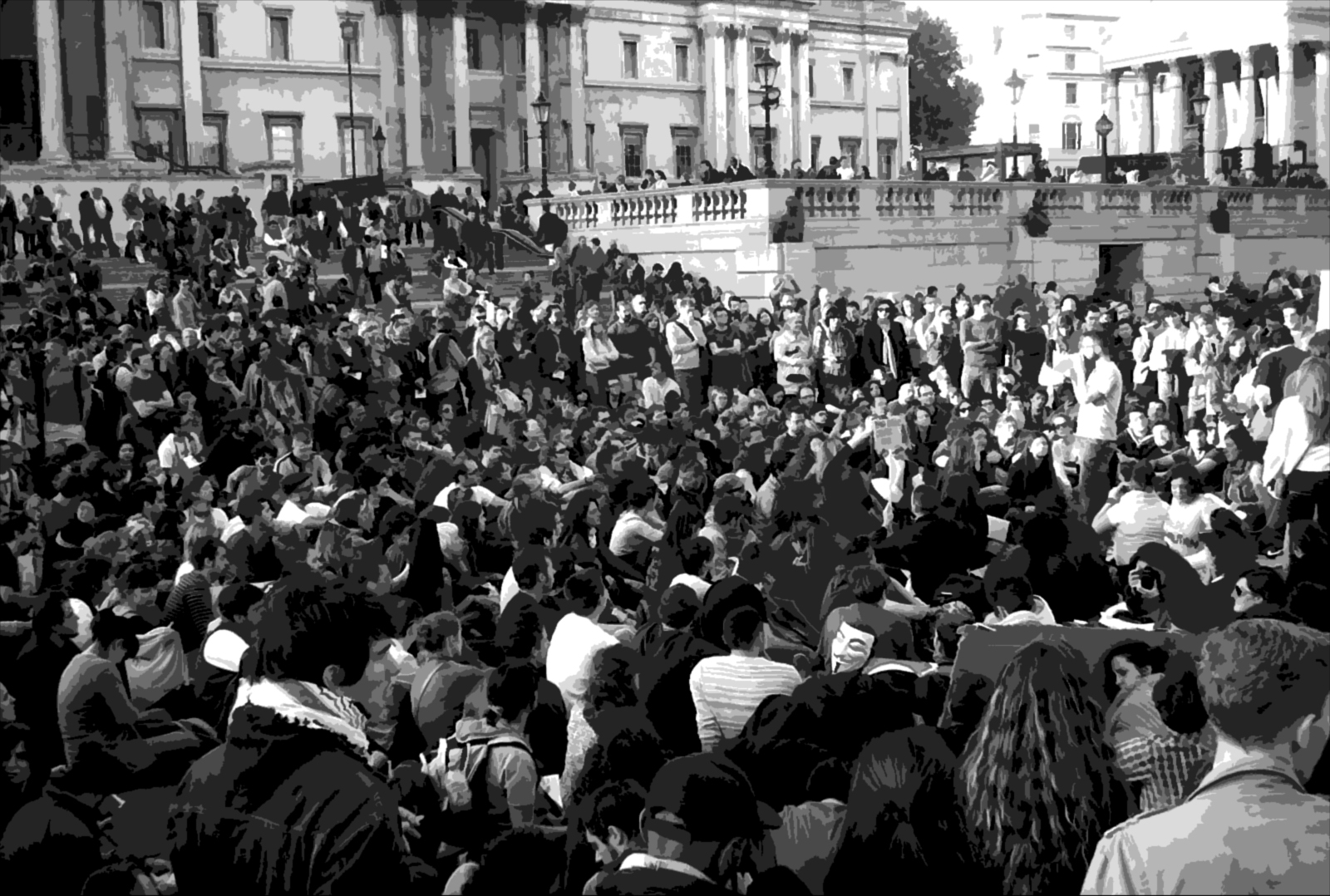Several weeks ago in one of the Zoom calls which have since become a pervasive aspect of everyday life under lockdown, a friend introduced me to a new and promising group called the Angry Workers Collective [AWC], brought into existence a mere 6 years ago, adding that “There’s a very real and refreshing militancy to them, totally apart from the usual circles.” Earlier this year, they released a book documenting their cumulative experiences and ideas, titled Class Power in Zero Hours; it is perhaps the most important book to have been published in recent decades for understanding and improving the political situation for the British working class today.
So many leftist political organizations operate by following the top-down, elitist structures which they denounce in theory, but show no scruples about deploying in practice. “Materially the new left intelligentsia reproduces itself as the ‘neoliberal self’ that they pretend to criticise: hardly any of them are ‘organic intellectuals’ forged in working class existence and struggle, most of them survive by creating a social media and academic persona whose opinion is valued on the marketplace.” In the midst of this culture, interventions into working class lives by such leftists seem patronizing and careerist. “We suggest a different kind of class politics, one that is embedded in the daily lives of working class people.”
The members of this group are not privileged academics or political commentators lacking all practical contact with the lives of working class people. One of them is a Tesco delivery driver; another a forklift driver for Bakkavor; a third member was a worker in a 3D-printer manufacturing company. Most of the book is a documentation of their daily experiences. Few of the stories they include in the book amount to working class victories, because workers at large feel so disempowered and inured that they are unwilling even to stand up for themselves against the dual powers of the complacent and opportunistic union apparatuses, and the increasingly centralised major industries which intentionally push workers to a state of exhaustion. With this as the atmosphere of their activism, the AWC have had to fight incredibly hard to win victories for the working class in any capacity.
In my opinion, the most salient message of Class Power on Zero Hours is that the working class do not need middle and upper class benefactors to thrive. Evidencing the necessity of reclaiming organizational independence for the working class, many of the struggles recounted in this book are resultant of corporate meddling via middle class ‘community leaders’. Because of the privileges held by such middle class ‘representatives’, they quickly lose solidarity with more modest assembly line workers; their distance from the working class increases as well when they are bought out by management, as happens dismayingly often. In fact, the most pointed examples from the book are where management hand-pick representatives for their workers based on their already established partisanship (in the Bakkavor warehouse, management’s union leader of choice, referred to as ‘The Bully’, is related to the warehouse administrators).
Nor are unions just ‘bad’ in the view of AWC. Unions do, in many cases, improve the lives of individual working class people. The structural problems of the union system do not prevent it from benefitting its service-users on many occasions, but they do prevent the union system from being a tool for revolution. Despite their wide-ranging critiques of the union system, many members of AWC are also active members of the revolutionary union IWW. Given this, I found it surprising that their critiques of the union system appeared to treat the term ‘union’ as synonymous with moderate unions like GMB and USDAW. It would be interesting to hear the AWC’s perspective on where revolutionary unions like IWW fit into their distrust of unions. It is of course possible that the IWW ought to be distrusted on the same grounds as the USDAW – whose upper echelons are dominated by members of the Socialist Party – even if this was not made explicit in the book.
Class Power on Zero Hours also manages the difficult task of shining a light on many of the tensions in contemporary leftist organizing, without expecting there to be an easy (theoretical or practical) solution to these tensions. How do we encourage workers to view their struggles collectively rather than individually, when most (especially migrant) workers just want to get on with their lives without the messy business of strikes and insurrection? How do we connect the short-term goal of making workers’ everyday lives better through representation and empowerment to the long-term goal of inspiring revolution (especially when successes in the short-term further entrench capitalism, making the long-term goal even harder to achieve)? How do we help workers without being seen as service-providers by them, creating an unwanted dynamic of dependence and deferral? Some of the central tensions we need to be dealing with collectively on the left are accordingly between the local and the global, reform and revolution, and the teacher and the colleague.
AWC propose a model of ‘levels of organization’ which helps to overcome some of these tensions. These levels are “workplaces, solidarity network, newspaper and organization”, between all of which a dynamic interplay needs to be inspired that fosters in workers a sense of solidarity as the basis for collective action. Firstly, by organizing workplaces they hope to inspire the autonomous coordination of the immense industrial and political power held by workers. They believe workplace organizing should be guided by two things in particular: “more workers coming together, what we call a ‘concentration process’, and daily co-operation between workers – [these] are the actual bases for the revolutionary potential of the working class.” Secondly, the solidarity network is meant to help workers with their struggles outside of work (dealing with landlords, finding childcare, and so on) which serve to reproduce a “dog-eat-dog atmosphere” that discourages working class revolutionary organizing. Having a working-class solidarity network helps to reduce working class dependence upon middle class benefactors by providing them with the means to look after each other instead of deferring action to middle-man organizations.
The third level of organization, the newspaper, is “necessary to be able to share experiences from the solidarity network and from workplaces and to reflect upon them.” Printing and distributing a physical newspaper also helps put groups like AWC in direct contact with workers. This direct contact shows workers that these groups are made of real people – fellow workers, even – and allows diverse contacts to be made through the local body of workers. Lastly, AWC specify that the fourth level, organization, “is not a label, a party name, a holy grail. ‘Organization’ is us thinking and acting together and reaching out to others. […] Our organization has to be of practical use for the working class and at the same time provide a compass: these are the conditions for our class to act independently from the parliamentary and state system, and these are the steps the movement can take to capture and defend the means of production.” By coordinating the interaction between workplace, solidarity network and newspaper, organization can help workers place their struggles in the context of political movements worldwide, helping to inspire an internationalist politics that is still closely attuned to the needs and concerns of working class people on the local scale.
I found it disarming how AWC managed to avoid deep theoretical discussions for most of their book, although terms they use throughout like ‘organic intellectual’ and ‘contradiction’ are theory laden. The last quarter of the book is noticeably different from the rest of it in this respect: the sudden change of pacing and content made the final sections feel almost like a different work that could be published separately, as either a manifesto or a manual for strategic organizing. The insights they offer in this last part are important correctives to various orthodoxies on the left, such as democratic socialism, unionism and syndicalism. I would encourage everyone to review these closing sections, even if they do not have the time to read the whole 386-page work. AWC’s comments in this last part also function as reflections on the difficulties they have experienced in deploying their levels of organizing, although I do not believe that enough was ultimately said to explain their frequent difficulties increasing the readership for their newspaper. In their own times both Lenin’s Pravda and Marat’s L’Ami du Peuple were certainly important in instigating revolutionary struggles and disseminating radical theory, yet it is possible that the newspaper today has lost its potency as a political tool with the growth of other forms of media, and in relation to the forms of class consciousness in our current historical conjuncture.
In the theoretical segment of their book, AWC also take the opportunity to denounce the ideas of “middle class” theorists like Antonio Negri and Nick Srnicek who develop concepts like the ‘multitudes’ or ‘accelerationism’ without paying attention to the practical dimensions of these concepts. Srnicek especially is a member of the techno-enthusiast, reformist current of modern thought, believing in a future of full automation within the workplace. To this prospect large parts of the book are devoted, describing the incredible lack of contact with warehouse and assembly-line labour one must have to believe that full automation is either desirable or practical. Instead of this, AWC recommend focussing on the concrete struggles related to the “elimination of unproductive work tied to the money economy and an equal redistribution of work [which could] reduce the daily working time to three hours immediately.”
Although many of their criticisms of modern political theory are well founded, I nonetheless feel that AWC are occasionally over-eager to rebuke recent developments in the field, such as in their sweeping claim that “Decades of neoliberalism has led to postmodern thinking within the left intelligentsia, which can only focus on difference: the patchwork of unwaged and unfree labour; the sphere of reproduction; the precarious professionals; the talk about ‘service’ or post-industrial society; privilege discourse.” Some of this critique certainly strikes at the heart of popular modern discourse about ‘social justice’, although it overlooks the revolutionary currents in so-called postmodern thinking associated with Fredric Jameson or David Harvey for instance. Additionally, their consignment here of “the sphere of reproduction” to the same theoretical periphery as “privilege discourse” and all other things ‘postmodern’ belittles the successes of contemporary feminist initiatives and movements, like the unionisation of sex workers and Women’s Strike. Although there are discussions of what is unique about women’s struggles in the book, this subject deserves to be taken more seriously, and given a more central place.
Despite the aforementioned complaints, AWC deserve all the acclaim they have received and more for their exemplary efforts in revolutionary organizing, which they have successfully laid out in an accessible way in their book. I sincerely hope that Class Power on Zero Hours gets the wide readership it deserves, and on anyone who has read it in full there lies the onus of propagating their newfound militant understanding as far as possible – especially within working class environments where it can make a difference. After all, “The word on the street [is] ‘Bakkavor is hiring!’”



